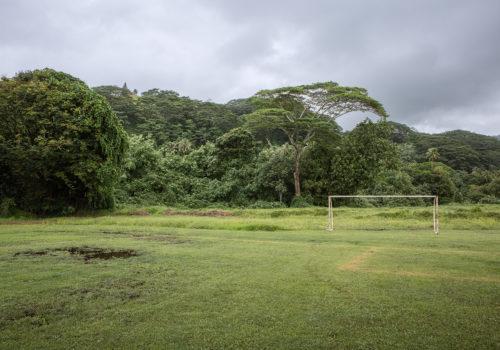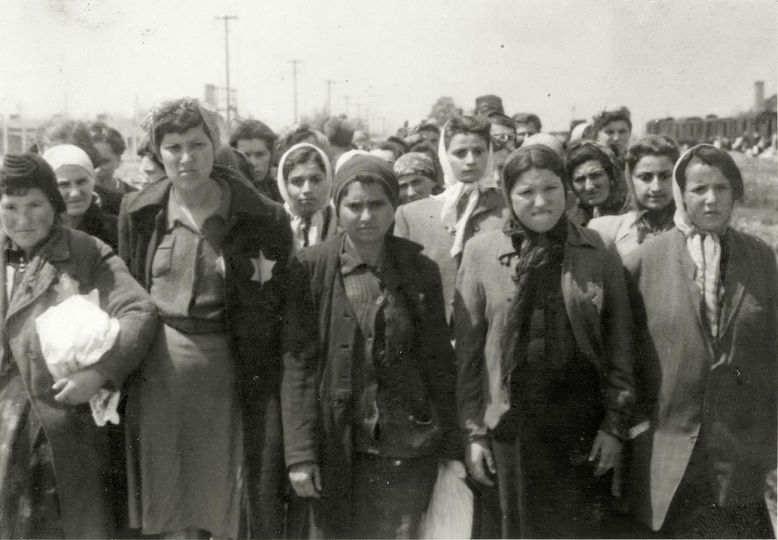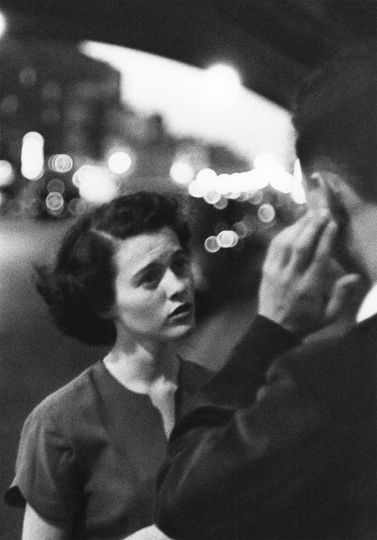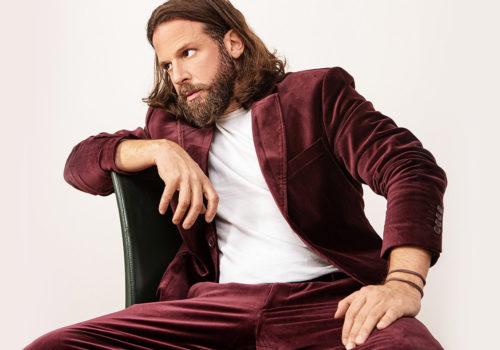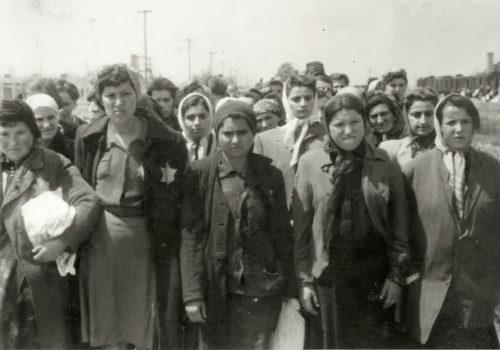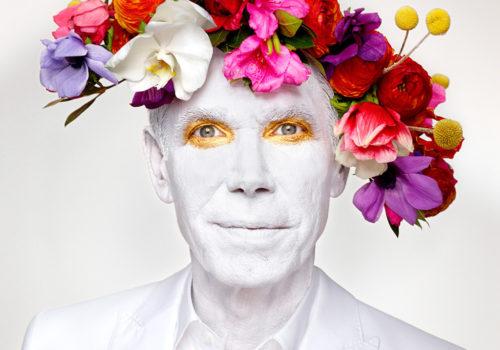Goals, Goals, Goals is a long-term photo project by Rui Camilo with an essay by Klaus Kleinschmidt.
A shrub on a field greens intensly. A dog is lifting his leg. And Rui Camilo, watching from the side with his photographer’s gaze, is alert. A dog peeing on a field. Nothing unusual in that. But this is not just a field. It is a football pitch. And Rui is not just a photographer. He has had football in his blood since he played as a child. And that dog is offside!
Rui continues watching the creature as it trots towards the horizon where there are tall palms beneath the sky, their colour ranging from olive to lime-green – like the dense bushes all around. In the middle distance, there is hint of sadness: a dingy shack, with walls stretched almost to infinity, dirt-white; its corrugated iron roof partly gone, rust-red. Bicycles, lined up as in a long chain out in front. And then Rui sees, at the back of the pitch, a football goal: devoid of its net, enormous and yawning, yet unobtrusive for all that. In that moment it hits Rui that, in its aimless wandering, the dog has led him to something he had long ago abandoned the search for: His idea for this project. Was this a sign from up above? ‘God is the soul of animals’.1 Goals! Goals far from all fan hype and superstars. Goals on all kinds of ground.
‘And in all beginnings’, Hermann Hesse tells us, from back in 1941, ‘dwells a magic force.’2 For the Irishman Samuel Beckett, ‘The end is in the beginning’ 3 – rather punishing prose from the pen of the nihilist in 1948–1949.4 Whilst, for Theodor Wiesengrund the matter was dialectical: ‘Even in the beginning, the end.’5 Each one of these bons mots rings true. All three tell us how a concept is spun out. And that soccer goal – that netless, unobtrusive object – calls to mind all kinds of portals: a gatehouse, a sluice gate, an arbour; a city gate, a wicket, a portcullis; and, like all of those, it marks a site of transition from outside to in and from inside to out. Only the gates to the Garden of Eden or the doorway to Hell lead into anywhere beyond. Paradise is high up in Heaven, whereas the way to Hell spirals into the earth, deep down into the mountains. A theme or concept arrives haphazardly, at times.
Rui Camilo, whose full name Rui Manuel de Assis Camilo sounds like music to the ears has pho- tographed all kinds of goals on the world’s recreation grounds. Why? ‘I was searching for something that would strictly define how I was going to record land- scapes. Therefore, I chose a goal on an informal play- ing field one time, and on a proper football field the other time.’ Looking at the situation through the view- finder, the goals defined the space surrounding them.
‘The concept cleanses the photograph of my personal, cultural, subjective backstory. Furthermore, a fixed, viewpoint was always repeatable.’
‘It sets clear limits on my freedom of design for the composition. When taking the shot, it forced me to occupy myself with the landscape surrounding the goal, so I could draw my conclusions from that. Goals and pitches reveal a lot about their geographical and social context.’ And that is the case, indeed: each goal bespeaks the world behind it.
A whole world opens itself to us through goals: in the mountains, in the jungle, in the city, or in the village; in the country in the provinces; on the beach, in suburbia, in the steppe; in mangrove swamps, against majestic backdrops; in the desert. There are various kinds of goals. Rui has compiled a typology of them: makeshift ones or stopgaps, for instance, or those carefully planned playing grounds built by local authorities that resemble oppressive open-air cages. Goals made out of bamboo or palm fronds are juxta- posed with ones that are built robustly out of wooden posts or constructed as an unyielding steel cage, intended to be indestructible for all time. As an eth- nologist and sociologist, Rui Camilo has visited and studied goals across the world. He is a fan, quietly showing us goal after goal after goal. As the decades past, this became a genre.
The son of an agricultural engineer from the Serra da Estrela – at 1993 metres, Portugal’s highest mountain range – Rui Camilo was born, in Lisbon in 1964, and stepped into the world through all kinds of portals. He was shaped by outdoor life on his parents’ farm, situated about 200 kilometres away from the metropolis. Today, the Serra da Estrela is a natural park. Rui Camilo likes to take a grounded approach in all that he does. His father’s profession caused him to be aware since childhood of the merit of firm soil under one’s feet. From clod to ball, it is just a few steps. In the mountains, every step can quickly be a step too many – into the abyss.
‘I played lots of football in my youth, I loved it.’ It was often on simple pitches – and then later, in soccer clubs. ‘I was usually the right-back. And the high- est league I played in was the district league.’ Defender Rui approaching the penalty area, running at full pelt.
From footballer to photographer, it was just one more step. But from football to photography: that is a long way. And goals need to be set along it. While the child’s aim was to get the round thing to go into the rectangular thing, later as a student it was completely different. By that time, he had long been concerned with finding gateways into the world that were likely to advance his career goals. Studies in photography followed. For the photographer, the round thing, this time, was not the ball, but his convex lens capturing the square properties of the goal and rendering it onto the plate. That was not always easy for Rui Camilo.
But there were role models to be found in the history of photographic art. The Düsseldorf por- traitist Horst Wackerbarth, for instance, would be one of them. With his Red Couch Project, which has been ongoing for decades now, he set the global standard for concepts of such a kind. And as we have seen, Rui Camilo found his way of ‘framing’, for his ‘Goal’ series in an instinctive, unconscious, almost aimless way. A portrait photographer such as Stefan Moses from Munich, who soberly uses his sitters’ background in such a way that the set unmasks the illusion, should not go unmentioned at this point. But portraiture can- not really help to explain a series like this one about goals. After all, a goal is not a face that returns the gaze. It is simply object not subject.
The object-like nature of the goals across the world, therefore, virtually forced a typology. There- with, Rui Camilo was directly on the side of Bernd [1931–2007] and Hilla [1934–2015] Becher. He had studied their work as conceptual artists over decades down to the minutest detail: industrial monuments form a meticulously compiled typology of all active or obsolete headframes, blast furnaces, water towers in Germany. The need for sobriety and objectivity, during their shoots on location at the time, demanded everything from the photographer couple. Every industrial structure was scrutinised for and reduced to quite particular features. Only that way could a typology be compiled that retained its expressiveness. Rui Camilo had learned that.
Jeff Wall’s concept, for example, is also relevant but entirely different. He used photography to meticulously stage and structure random events and so join them to the image of the landscape. However, Rui Camilo’s work is closer to the photography of one Joel Sternfeld [1944], who elevated the urban space to a topos. But if one really wants to identify a tradition to which Rui Camilo, as a photographer, is aesthetically a successor then the name Stephen Shore [1947] must be mentioned. He, more intensively than almost any- one else, photographed the suburbs and big-city peripheries in America’s West. With him [Shore] as with Camilo, all coincidences are real – and thereby serendipitous. All that Rui learned, as it were, from those three protagonists of New Color photography – Shore, Sternfeld, Wall – is their subtle intuition for colour.
In the photo project Common Ground, Rui Camilo demonstrates how he, the Portugal-born photographer, has long been assimilated as a German and cosmopolitan. He does so, for instance, when he draws on the exemplarily German stringency in the Becher school tradition, which is ever-present in the aesthetic discourse and photographic canon in that country, and almost effortlessly combines the latter’s tendency towards typology with the grandiosity of American landscape photography by one Walker Evans [1903–1975]. With Evans in particular, seren- dipity is at work. And is it not so that the picture-frame was also only invented through serendipity, back in medieval times, when the lord and lady of the manor looked out of their drawing-room window one evening and became aware of how sublime and beautiful that untouched slice of nature out there was, and how charmingly pacified and bounded it seemed from inside? In the Middle Ages, therefore, an ordinary window-frame served as a prototype for the pic- ture-frame, ennobling the picture into a work of art, and thus raising it into a new dimension and sphere. Just as the window-frame once served as pic- ture-frame, so the goal in Rui Camilo’s photo project serves optically as an entrance into the landscape.
But goals are not always portals into a world that opens and widens its space behind them. Primarily, they form a constriction, with no apparent exit. This drawing of boundaries is deliberate. The endeavour to score a goal is by no means supposed to be easy. On the recreation ground, for example, it is not uncommon to play with a small goal measuring just 3 by 2 metres. Germany’s youth team usually use one measuring 6.40 by 2.20 metres. Only in the world’s official leagues –does the goal have to be 7.32 by 2.44 metres in accordance with IFAB and FIFA rules.
These large, officially defined goals, it should be noted, form an aspect ratio of 1:3. That is almost a panorama, and it explains why, when he is not choosing the portrait format that anyone else, more conventionally, would use for a portrait, Rui Camilo also likes to luxuriate in the landscape in order to cap- ture a horizontal format (which every football goal represents, after all) in the vertical. That is another violation of the rules. Why does he do that? The logic is pictorial: the vertical format corresponds to the player’s vision on the field as he runs at the goal. With its verti- cality, the portrait format brings out the goal-strike- like aspect of the pictorial structure and thereby propels perspectival vanishing-points forcefully ahead across the playing-field into the: Goooal!
Carefully, he tests the shooting-point from which he will make his approach, wherever that is in the part of the world he is currently in. Usually, this is a point, sometimes half-left, sometimes half-right, often hard on the line to the penalty area, occasionally even from the semi-distance. From the 20–30 metre perspective, the line of shooting can be set up firstly straight towards the goal, and from there to build an accomplished landscape composition. But how does he achieve this?
Rui Camilo has a special sense of colour and form. Similar to the founder of abstract painting, Wassily Kandinsky, he apparently has the gift of empa- thy. This gift – known in medicine as synaesthesia –
manifests itself in the ability of certain people to hear colours, for example, as a colour tone or ‘hue’. This involves the stimulation of one sensory organ [ear] by the stimulation of a completely different sensory organ [eye]. Some particularly sensitive painters can hear or smell colours. Wassily Kandinsky’s colour theory from 1911 is based on this insight and the phenomenon known since then.6 He created painted music from the palette of his colour tones. His abstract compositions are orchestrated as symphonies.
Rui Camilo’s sense of colour also proves to be extremely nuanced. There are very soft tones, but also shrill ones. He moves from colour to form. The dot is the beginning. Many dots form an initial line that guides the eye. Many lines draw out the surfaces: the field. Alignments finally form the perspective or meet outside the edge of the picture – in infinity. The gate often stands abstractly and completely white as a rectangle in the landscape. It is the goal. Only now does the surface open up into space. There is no doubt about it: the footballer Rui Camilo uses point, line and surface to explore the scope that the photographer captures at every turn.
When, already in 1926, Wassily Kandinsky was teaching the basics of painting at the Bauhaus, he wrote his opus ‘Point and Line to Plane’.7 His theory swiftly became a global benchmark for modern com- position. The rules of photography’s second dimension apply in the third of space. The configuration of every recreation ground and football pitch still follows his example today, in this sense: the centre mark and penalty spot draws a line or a pass – from the player straight into the goal. The pitch’s surface takes the shape of a drawing. Every shot in the form of a header or high pass forges its way through the space.
Diagonals in the foreground push ahead into the pictorial space and, in doing so, ‘ideally’ depict the landscape in the background by pulling the vanish- ing-points from outside the picture into the offside. The penalty kick as model image: Rui Camilo as a photographer is always a footballer too. The player on the pitch always sees the football pitch in vertical format. Depending on the league this is usually 90 to 120 metres long by 45 to 90 metres wide. If the portrait – vertical – format depicts the landscape from the player’s point of view, then only the specta- tor’s view – in the horizontal format, in this case – illustrates the landscape objectively. For Rui Camilo, the vertical format is his playing leg; the horizontal format, it is clear to see, is his jazz leg.
Camilo’s biography is characterised by life’s vagaries and imponderables. Up until his sixth year, he spent his childhood quietly on his father’s quinta in the village of Nelas on the edge of the Estrela mountains. Located school, the family moved to Paço de Arcos – still a small fishing village back then – at the mouth of the Tejo near Lisbon.
‘My father died in 1972, when I was seven years old. When the Carnation Revolution broke out in Portugal in 1974, my (German) mother was uncertain whether she, as a widow in Portugal and now alone with two children, ought to settle down without support. Unable to decide, she moved with my sister and me to Wiesbaden, where my grandfather was a clarinettist at the Staatstheater.’ But the children and mother alike experienced their first year in Wiesbaden as a time of turmoil. So that, too, was a Book of Unrest.8 Rui: ‘A year later, we moved back to Portugal, because we couldn’t really get used to German life, but unfortu- nately we weren’t able to build up a proper existence at home in Portugal either, So we ended up stranded in Germany again a year later. I continued going to school in Wiesbaden from then on.’
Rui Camilo later studied Visual Communication at the Rhein-Main University of Applied Sciences in the state capital. After several years as an assistant in Germany and in London, he began to work independently as a freelance photographer. Alongside his commercial work, he developed personal projects – usually with the focus on the signature man leaves behind on his habi- tats. He is constantly in search of clues. And in this quest, he deals with change and the consequences of rapidly changing urban structures in the world of work and the world of life. He seeks to visualise and document human upheavals in society and culture.
The idea that the rules of football are fol- lowed and recognised all over the world – regardless of which community, culture or religion a footballer feels they belong to – was added to his concept later.The sim- ple desire to meet up to play football unites people every day all over the world. Together these people form a community network. Rui sees this is a blueprint for how people can compete with each other peacefully: ‘People are only fully human when they play.’9
Viewers of the goals that Rui Camilo has shot will naturally wonder: Why is there never a goal- keeper? Rui explains: ‘For one thing, there was not always a match being played when I happened to show up at the recreation ground. For another, it was pre- cisely the peace and calm of the place that I wanted to capture. That would not have been possible, even with just one team on the pitch. Also, it was easier for me to make the series look uniform without any goalkeeper and players.’ But that, of course, is only half the truth.
The question to the photographer remains unanswered: What attracts him to an empty pitch? Why do we see no players? Where is the goalkeeper? The mystery contains a conundrum: the constantly empty pitch. After the game is before the game. One Gregory Crewdson would relish this. Rui Camilo: ‘Whenever I see empty pitches I try to make out traces of life from the surroundings ie from the immediate vicinity of the landscape. What kind of people play foot- ball there day to day? Are they labourers, letting off
steam after work? Or cool, but bored hipsters? Or happy and boisterous children? Goals and pitches reveal a lot about their local and social context.’ Rui Camilo operates like a detective. His crime scene is always the space in front of and behind the goal. There is no doubt: a sociologist is on the hunt with his camera for footprints on the playing field. He seeks. He finds.
For Rui Camilo the traces – or what he terms ‘signatures’ – left by players after their game are essential to his shot. Thye generate their effect precisely, through the absence of the players. That, then, would be the whole truth: in this photo project, the players’ absence is the premise. Viewed in that way, all Rui’s goals are crime scenes. With the aid of the camera, he goes off on a search for clues, looking for the past game, all past games, whose time is lost forever in the past. Corner flags and goal lines mark out the field of memory; ultimately, though, it is the traces which provide the material for the beholder’s imagination. And thus, Rui Camilo reveals interior pictures in: us.
His method creates a deep connection between playing field and background. A landscape often arises Arcadian-like in the distance. At times, it towers almost majestically, even spectacularly, in hori- zontal formats. And the aura he captures tells, in the situation’s Here and Now, of the magic of the sur- roundings, the traces of urban life, the condition of a pitch and of its goals.10 That all says more about the places than any players on the field. They would dis- turb the spirit of the place. Camilo: ‘And for another thing, I like the idea that these “portals into the world” are unobstructed, not guarded by a goalkeeper.’ The gatekeeper from projects. But it is entirely irrelevant where I shoot the goals. The important thing for me is that you can find them everywhere in the world – without even having to search for them. I was always guided by chance. It decided everything. I usually just stumbled upon the pitches where ever I happened to be.’ This guiding hand of serendipity resulted in a strangely deep con- nection between the football pitch and the viewer. The landscape speaks. It tells of the place’s situation and its surroundings, the condition of the pitch and of the goals – not of the game in itself.
Finally, the question arises: Is the photo- grapher of all these goals, now, more a portraitist or a ‘landscapist’ in his work? Rui Camilo: ‘I would say that I’m both. The background is central in any portrait. And indirectly, the whole surroundings play a role too. In the end they are just as important as the portrait-sitter himself. The two are inseparably joined. To take a good picture, you need to harmonise protagonist and back- ground. That is the approach I retained in the “portraits” of goals.’ The truth of this statement can be seen when one considers that although, goals by their very nature exist in the horizontal format, Rui has shot them all in portrait format, In essence, then, his goals reveal landscapes around the world from the perspective of a sweeper who, favoured by serendipity, then goes all out as a striker. In the book, that is on display as a double page: Goal!
Kafka’s parable springs to my mind. He could be the goalkeeper’s colleague since he con- stantly refuses entry to the hero K.11 Only in death – the reader summarizes – is K able to enter.
It is a different picture in Rui’s life: ‘A goal is always a symbol. It is a link between two places, two worlds, two ideologies. The goal is there to be stepped through.’ It is not just the footballer speaking here. Rui, the photographer as contractor is always doing his job on site: ‘The goal conects different spaces or even per- ceptions. Sometimes, we need to ensure that a goal is clear or, more usually, that it is defended. It all depends on whether you’re on the pitch as a photographer or as a footballer. In the game, that is the goalkeeper’s task.’
The conclusion of his concept is precisely this: already in the beginning, the end. What, then, does his first goal reveal to us? Rui Camilo: ‘I photographed my first goal more than twenty years ago, now, on Bali in Indonesia.’ ‘The Incindental’ was the theme. A dog ran across the recreation ground there and raised his hind leg. It was only on second glance that Rui saw more: ‘Behind the dog was a goal – it was entirely unob- trusive. And that gave me the idea for the series. Those sorts of places existed everywhere.’ Over the years, his collection of goals grew. So how, I want to know, did the selection of each place come about?
Rui explains: ‘As a photographer, I travel professionally and do a lot of travelling for my own about 30 kilometres north-west of the Torre, the village is close to the beautiful Serra da Estrela natural park. His father had worked both as an agricultural engineer and architect but had moved back to Nelas in order to recover in peace from a serious illness. When it was time for Rui to start.
(1) Deus est anima brutorum. Dictum by a famous scholar in the Middle Ages. Thomas Willis [1621–1675] or Thomas Aquinas.
(2) Hermann Hesse: Stufen 1941. The author wrote the line in his poem ‘Stufen’ on 04.05.1941.
(3) Samuel Beckett: Endgame. 1949. The character Hamm says in Endgame: ‘The end is in the beginning and yet you go on.’
(4) 1952 was the year of the première of Samuel Beckett’s Endgame.
(5) Theodor Wiesengrund Adorno: Minima Moralia. Edition Suhrkamp.
(6) Wassily Kandinsky: On the Spiritual in Art. Benteli publishing house, Bern 2013.
(7) Wassily Kandinsky: Point and Line to Surface. Benteli Publishers, Bern 2013.
(8) FernandoPessoa:LivrodoDesassossego.Lisbon 1982. Translated from Portuguese into German by Georg Rudolf Lind. Das Buch der Unruhe. Ammann Verlag, Zürich 1986. Cited within on page 98: ‘My victories were everywhere I have never been.’
(9) Friedrich Schiller: Upon the Aesthetic Education of Man. The citation within it: ‘Man plays only when he is in the full sense of the word a man, and he is only wholly a man when he is playing.’
(10) This concept of aura is central to the artwork in the age of its mechanical reproducibility. We find it defined by Walter Benjamin thus: ‘The aura is the unique phenomenon of a distance, however close it may be.’ (11) Franz Kafka: Der Prozess. Novel. Verlag Die Schmiede. Berlin, 1925. Facsimile of the first print edition of the book from 1925. As a supplement to the Historisch-Kritischen Franz Kafka-Ausgabe (FKA), Roland Reuss & Peter Staengle (ed.), Stroemfeld Verlag, Frankfurt am Main and Basel 2008. Citation within there on the famous gatekeeper parable: pages 375–392.
Rui Camilo : Common Ground
Editor : Chromfeld
Essay : Dr. Klaus Kleinschmidt
Graphic design : Arne Kaiser
Hardcover with French Flap, 30,5 x 22,5 cm
200 Pages, 226 colour illustrations
English / German
ISBN 978-3-9824299-7-7
https://www.chromfeld.com/en/produkt/rui-camilo-common-ground-edition/

